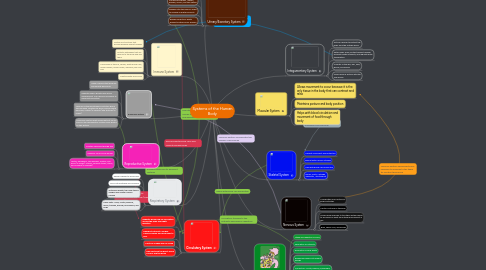Systems of the Human Body
by Josh Williams

1. Circulatory System
1.1. Regulate Blood flow for circulation around the body and fights infection
1.2. Transport nutrients, oxygen, Carbon Dioxide, and Hormones to cells
1.3. Controls oxygen levels in blood
1.4. Main parts are the heart, blood vessels, and the blood
2. Respiratory System
2.1. Deliver Oxygen to blood cells
2.2. Carry out Breathing and Diffusion
2.3. With each breath, the lungs take in Oxygen and release Carbon Dioxide
2.4. Major parts: Nose, mouth, pharynx, larynx, trachea, bronchi, bronchioles, and lungs
3. Reproductive System
3.1. Creates Offspring through Sex
3.2. Requires a man and a woman
3.3. Testes, epididymis, vas deferens, urethra, and penis (in males); ovaries, Fallopian tubes, uterus, and a vagina (in females)
4. Endocrine System
4.1. Made of glands that produce and secrete hormones
4.2. Regulate body's growth and sexual development. Also delivers hormones to reproductive system
4.3. Made up of the hypothalamus pituitary gland, thyroid gland, parathyroid gland, adrenal gland, pancreas, ovaries (in females) and testicles (in males)
4.4. Hormones control what organs get put on our body so the reproductive system relies greatly on this system
5. Immune System
5.1. System of structures that provide defense against disease
5.2. Detects pathogens that are harmful to the body and kills them
5.3. Composed of thymus, spleen, white blood cells, lymph vessels, lymph nodes, adenoids, skin and liver
5.4. Creates white blood cells
6. Urinary/Excretory System
6.1. Excretes any waste product from the body, regulates the electrolyte balance, and maintains homeostasis
6.2. Consists of Kidneys, ureters, bladder, nerves, and the urethra
6.3. Kidneys filter the blood in order to remove all waste products
6.4. Bladder collects all waste products filtered from Kidneys
7. Digestive System
7.1. Intake and digestion of Food
7.2. Absorption of nutrients
7.3. Elimination of solid waste
7.4. Breaks food down into usable energy
7.5. Consists of: Mouth, pharynx, esophagus, stomach, small and large intestines, and rectum
7.6. Villi allow nutrients to diffuse to blood
8. Nervous System
8.1. Coordinates and Controls all Bodily activities
8.2. Central controller is the Brain
8.3. Sends nerve impulses to tell other systems what to do based on what the outside environment is like
8.4. Brain, spinal cord, and nerves
9. Skeletal System
9.1. Support movement and protection
9.2. Benefit with Calcium Storage
9.3. Help with Blood Cell production
9.4. Bones, joints, cartilage, ligaments, and tendons
10. Muscular System
10.1. Allows movement to occur because it is the only tissue in the body that can contract and relax
10.2. Maintains posture and body position
10.3. Helps with blood circulation and movement of food through body
11. Integumentary System
11.1. Acts as a barrier to protect the body from the outside world.
11.2. Retain body fluids, protect against disease, eliminate waste products, and regulate body temperature
11.3. Consists of the skin, hair, nails, glands, and nerves
11.4. Helps nervous system with the five senses


